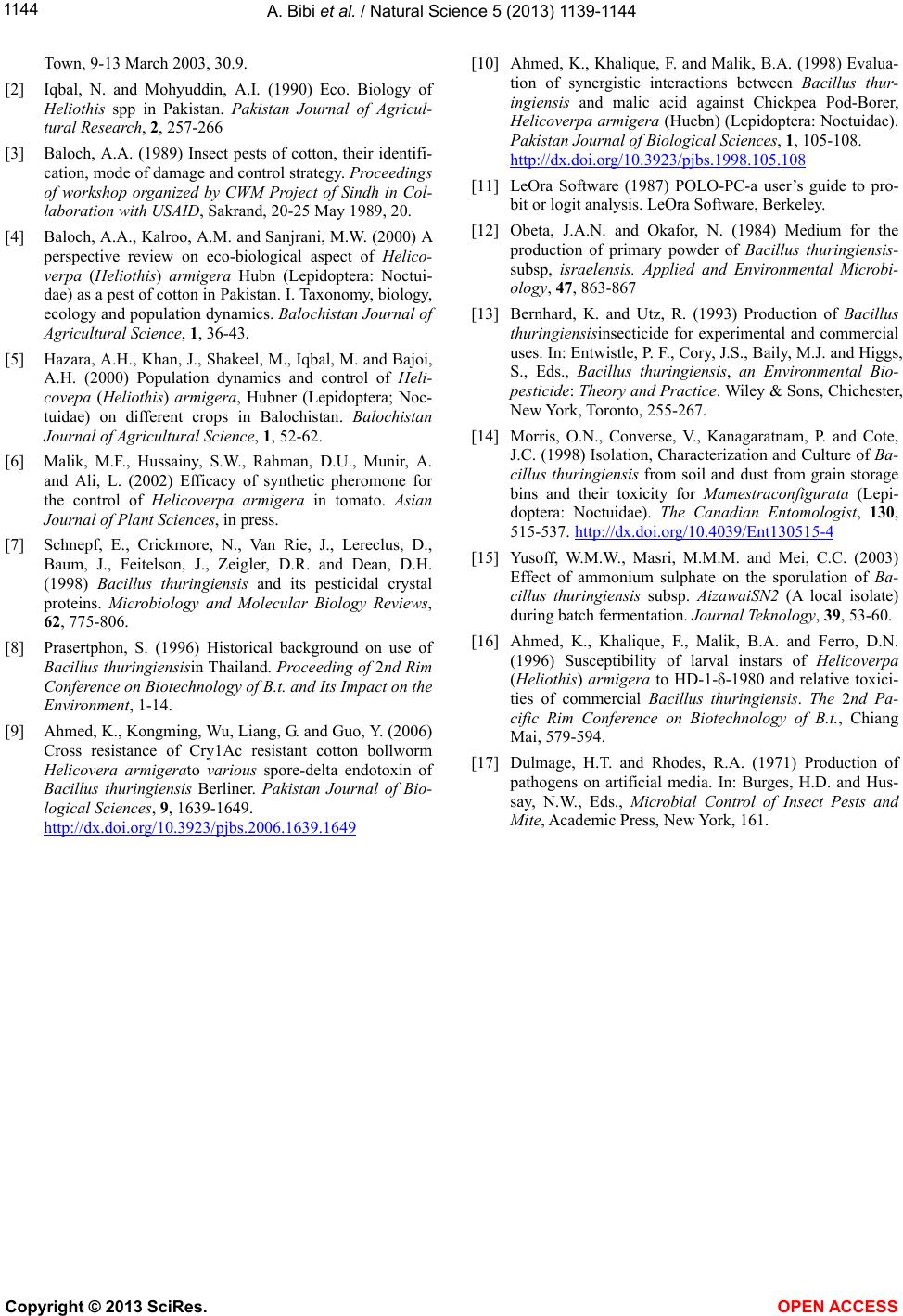
A. Bibi et al. / Natural Science 5 (2013) 1139-1144
1144
Town, 9-13 March 2003, 30.9.
[2] Iqbal, N. and Mohyuddin, A.I. (1990) Eco. Biology of
Heliothis spp in Pakistan. Pakistan Journal of Agricul-
tural Research, 2, 257-266
[3] Baloch, A.A. (1989) Insect pests of cotton, their identifi-
cation, mode of damage and control strategy. Proceedings
of workshop organized by CWM Project of Sindh in Col-
laboration with USAID, Sakrand, 20-25 May 1989, 20.
[4] Baloch, A.A., Kalroo, A.M. and Sanjrani, M.W. (2000) A
perspective review on eco-biological aspect of Helico-
verpa (Heliothis) armigera Hubn (Lepidoptera: Noctui-
dae) as a pest of cotton in Pakistan. I. Taxonomy, biology,
ecology and population dynamics. Balochistan Journal of
Agricultural Science, 1, 36-43.
[5] Hazara, A.H., Khan, J., Shakeel, M., Iqbal, M. and Bajoi,
A.H. (2000) Population dynamics and control of Heli-
covepa (Heliothis) armigera, Hubner (Lepidoptera; Noc-
tuidae) on different crops in Balochistan. Balochistan
Journal of Agricultural Science, 1, 52-62.
[6] Malik, M.F., Hussainy, S.W., Rahman, D.U., Munir, A.
and Ali, L. (2002) Efficacy of synthetic pheromone for
the control of Helicoverpa armigera in tomato. Asian
Journal of Plant Sciences, in press.
[7] Schnepf, E., Crickmore, N., Van Rie, J., Lereclus, D.,
Baum, J., Feitelson, J., Zeigler, D.R. and Dean, D.H.
(1998) Bacillus thuringiensis and its pesticidal crystal
proteins. Microbiology and Molecular Biology Reviews,
62, 775-806.
[8] Prasertphon, S. (1996) Historical background on use of
Bacillus thuringiensisin Thailand. Proceeding of 2nd Rim
Conference on Biotechnology of B.t. and Its Impact on the
Environment, 1-14.
[9] Ahmed, K., Kongming, Wu, Liang, G. and Guo, Y. (2006)
Cross resistance of Cry1Ac resistant cotton bollworm
Helicovera armigerato various spore-delta endotoxin of
Bacillus thuringiensis Berliner. Pakistan Journal of Bio-
logical Sciences, 9, 1639-1649.
http://dx.doi.org/10.3923/pjbs.2006.1639.1649
[10] Ahmed, K., Khalique, F. and Malik, B.A. (1998) Evalua-
tion of synergistic interactions between Bacillus thur-
ingiensis and malic acid against Chickpea Pod-Borer,
Helicoverpa armigera (Huebn) (Lepidoptera: Noctuidae).
Pakistan Journal of Biological Sciences, 1, 105-108.
http://dx.doi.org/10.3923/pjbs.1998.105.108
[11] LeOra Software (1987) POLO-PC-a user’s guide to pro-
bit or logit analysis. LeOra Software, Berkeley.
[12] Obeta, J.A.N. and Okafor, N. (1984) Medium for the
production of primary powder of Bacillus thuringiensis-
subsp, israelensis. Applied and Environmental Microbi-
ology, 47, 863-867
[13] Bernhard, K. and Utz, R. (1993) Production of Bacillus
thuringiensisinsecticide for experimental and commercial
uses. In: Entwistle, P. F., Cory, J.S., Baily, M.J. and Higgs,
S., Eds., Bacillus thuringiensis, an Environmental Bio-
pesticide: Theory and Practice. Wiley & Sons, Chichester,
New York, Toronto, 255-267.
[14] Morris, O.N., Converse, V., Kanagaratnam, P. and Cote,
J.C. (1998) Isolation, Characterization and Culture of Ba-
cillus thuringiensis from soil and dust from grain storage
bins and their toxicity for Mamestraconfigurata (Lepi-
doptera: Noctuidae). The Canadian Entomologist, 130,
515-537. http://dx.doi.org/10.4039/Ent130515-4
[15] Yusoff, W.M.W., Masri, M.M.M. and Mei, C.C. (2003)
Effect of ammonium sulphate on the sporulation of Ba-
cillus thuringiensis subsp. AizawaiSN2 (A local isolate)
during batch fermentation. Journal Te knology, 39, 53-60.
[16] Ahmed, K., Khalique, F., Malik, B.A. and Ferro, D.N.
(1996) Susceptibility of larval instars of Helicoverpa
(Heliothis) armigera to HD-1-δ-1980 and relative toxici-
ties of commercial Bacillus thuringiensis. The 2nd Pa-
cific Rim Conference on Biotechnology of B.t., Chiang
Mai, 579-594.
[17] Dulmage, H.T. and Rhodes, R.A. (1971) Production of
pathogens on artificial media. In: Burges, H.D. and Hus-
say, N.W., Eds., Microbial Control of Insect Pests and
Mite, Academic Press, New York, 161.
Copyright © 2013 SciRes. OPEN ACCESS